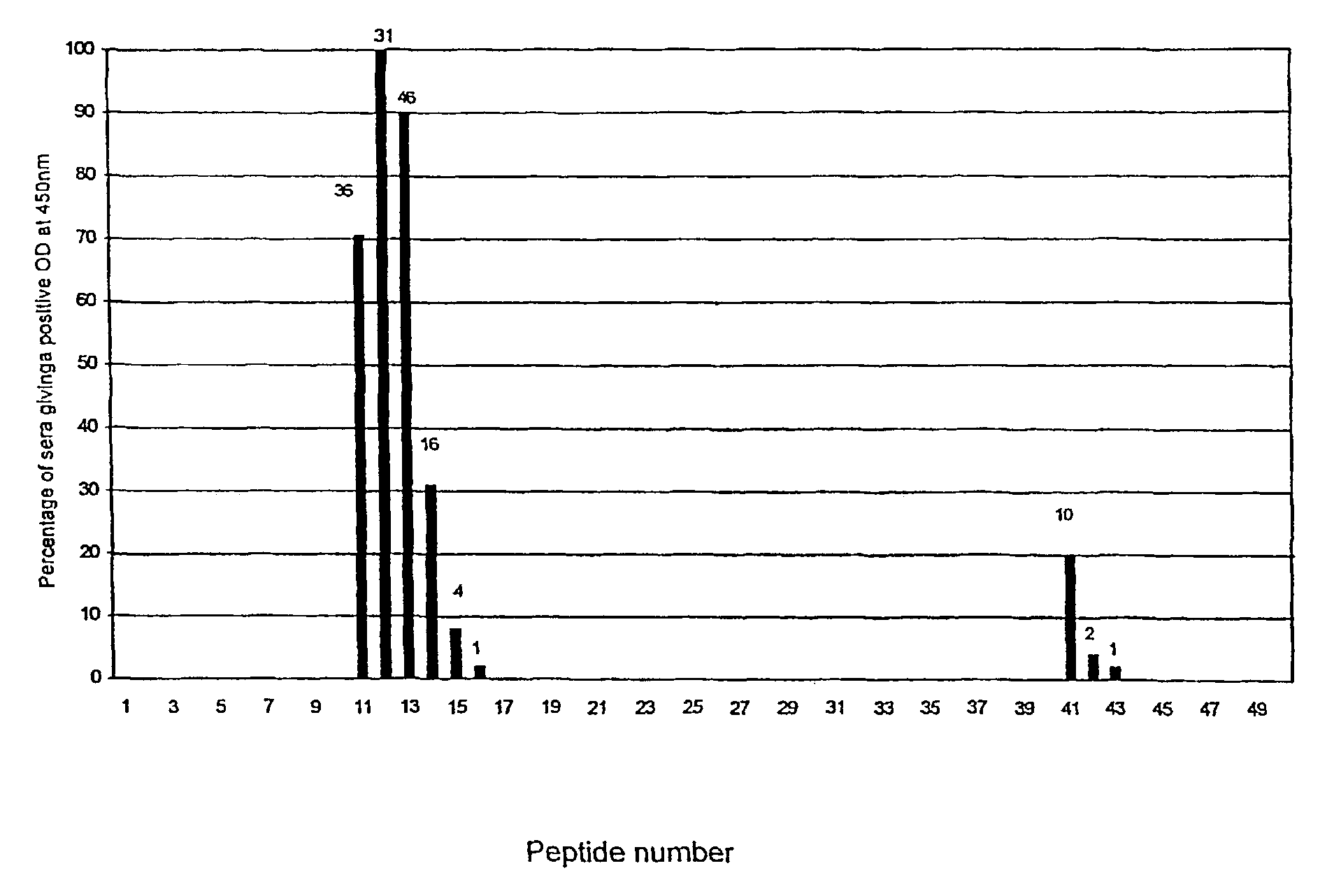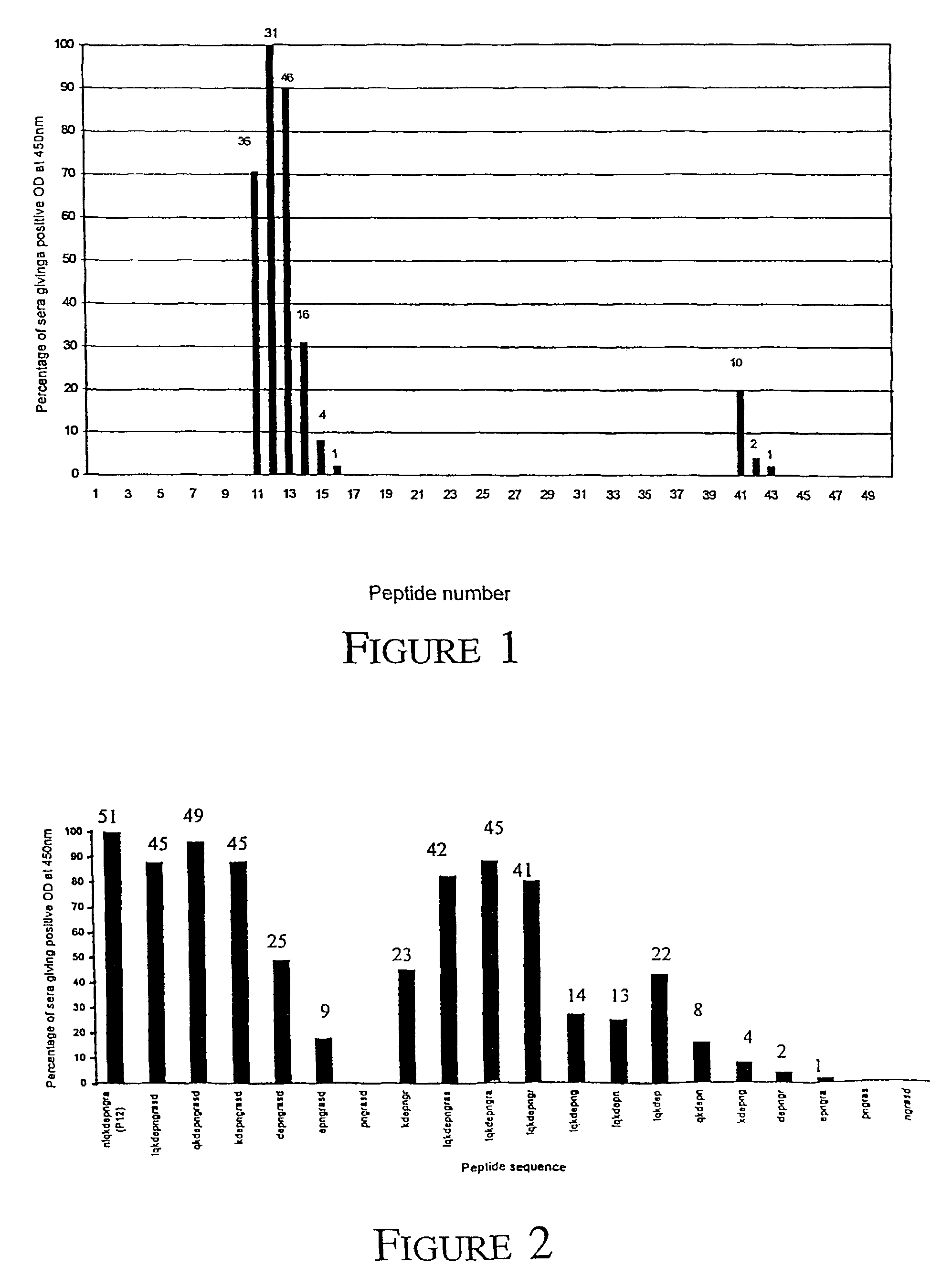Antigenic peptide fragments of VapA protein, and uses thereof
a technology of vapa protein and antigen, which is applied in the field of peptide fragments, can solve the problems of insufficient vapa protein alone, inability to identify i>r. equi/i>, and inability to achieve phenotypic testing, and achieve the effect of reducing the number of false positives and false negatives
- Summary
- Abstract
- Description
- Claims
- Application Information
AI Technical Summary
Benefits of technology
Problems solved by technology
Method used
Image
Examples
example 1
Peptide Based Assay for R. equi
[0094]A potential 20 amino acid region of the VapA protein that appears to be recognised by the sera of horses that have been infected with R. equi and is unrecognised by control horses which have not been infected by the organism was identified.
[0095]Biotinylated peptides synthesized by Mimotopes, Victoria, Australia were used in all assays. The peptide bank used in the initial screening of sera was designed based upon the published sequence of VapA (Genbank accession No: D21236). A total of 50 overlapping peptides, each 11 amino acid residues in length (offset by 3 residues at a time) were synthesized beginning from the predicted signal peptide cleavage site between amino acids 31 and 32 up to and including the C terminus.
[0096]A second set of peptides was used to further define the region between peptides 11 to 14 (LQKDEPNGRASD [Seq I.D. No. 39]) of the VapA protein. A total of nineteen peptides were designed based upon this region, twelve were tru...
example 2
Vaccine Development
[0113]The antigenic region or derivative peptide identified was synthesised with a (Hisitidine)6-tag at either the N or C termini. The 6xHis tag allows the peptide to bind strongly with Ni-NTA (nickelnitriloacetic acid) agarose thereby greatly increasing its immunogenicity. The peptide Ni-NTA agarose was then used directly with a suitable adjuvant (Freund's) as a sub-cutaneous or intra muscular vaccine (Sheibani and Frazier, 1998).
[0114]This vaccine was then used to determine whether it can elicit anti VapA antibodies in mice. This was tested by use of the mouse sera in an ELISA against the peptide epitope, and in Western blots to determine whether the sera can detect the VapA protein. Challenge studies then followed using the immunised mice. This entailed either intra peritoneal or aerosol inoculation of the mice with virulent R. equi. Protection against fatal infection was taken as good evidence that VapA is protective.
DNA Vaccine
[0115]pcDNA3 vectors containing ...
PUM
| Property | Measurement | Unit |
|---|---|---|
| concentration | aaaaa | aaaaa |
| temperature | aaaaa | aaaaa |
| OD | aaaaa | aaaaa |
Abstract
Description
Claims
Application Information
 Login to View More
Login to View More - R&D
- Intellectual Property
- Life Sciences
- Materials
- Tech Scout
- Unparalleled Data Quality
- Higher Quality Content
- 60% Fewer Hallucinations
Browse by: Latest US Patents, China's latest patents, Technical Efficacy Thesaurus, Application Domain, Technology Topic, Popular Technical Reports.
© 2025 PatSnap. All rights reserved.Legal|Privacy policy|Modern Slavery Act Transparency Statement|Sitemap|About US| Contact US: help@patsnap.com


